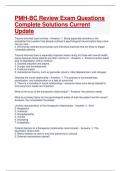PMH-BC Review Exam Questions
Complete Solutions Current
Update
Trauma-informed care involves - Answers -1. Being especially sensitive to the
probability that a patient has already suffered a psychological trauma before they came
into our care
2. Minimizing institutional processes and individual practices that are likely to trigger
vulnerable patients
Trauma-informed care is especially important when caring for those with mental health
issues because these patients are often victims of: - Answers -1. Personal and/or public
acts of degradation and/or violence
2. Societal prejudice and stigma
3. Hunger and homelessness
4. Profound losses
5. Generational trauma, such as genocide, slavery, tribal displacement, and refugees
Describe the social relationship - Answers -1. The purpose is connectedness,
socialization, and collaboration on a task of some kind
2. There is a mutuality in social relationships - everyone takes turns being listened to
and everyone's needs are important
What is the focus of the therapeutic relationships? - Answers -the patient's needs
What is a primary factor for the psychological safety of both the patient and the nurse? -
Answers -the nurse/patient boundary
List key characteristics of the therapeutic relationships - Answers -1. Kind
2. Respectful
3. Authentic
4. Nonjudgmental
5. Honest
6. Accepting
7. Empathetic
Patients barriers to a therapeutic relationship could include: - Answers -1. The
psychiatric illness itself
2. Being resistant to care of any kind (paranoia or cultural)
3. Defense mechanisms (denial)
,Nurse barriers to a therapeutic relationship could include: - Answers -1. Not being fully
focused on the patient's verbal and nonverbal cues (being distracted or preoccupied)
2. Countertransference with a particular patient
3. Asking patients "why" questions
4. Asking patients more than one question at a time
List several methods to enhance the therapeutic relationship - Answers -1. Maintain
professional boundaries
2. Use comfortable eye contact, empathetic facial expressions, gentle voice
3. Keep a relaxed, open body posture
4. Actively listen to what the patient is saying
5. Be fully self-aware
6. Use therapeutic silence to allow patient time to reflect and regroup
Describe the DSM-V - Answers -1. Published in 2013
2. Contains information about each mental health diagnosis, including a description of
the disorder, symptoms, and specific criteria for diagnosing
3. Contains cultural explanations and context for mental health diagnoses
4. Includes a list of all allowable specifiers
What are the allowable specifiers outlined in the DSM-V - Answers -1. Course of illness
(partial/full remission)
2. Severity (current intensity)
3. Descriptive features (types of symptoms present)
Describe characteristics of a mental health disorder - Answers -1. Impairment of brain
functioning caused by neurotransmitter dysfunction, abnormal brain structure, genetic
factors, or injury
2. Dysfunction in cognition, emotion regulation, or behavior
3. Inability to cope with life stressors
What is AIMS - Answers -Abnormal Involuntary Movement Scale
A five-point scale that assesses the presence and severity of abnormal extremity, facial,
and body movement, which is often a result of EPS from first-generation antipsychotics
- the higher the score, the worse the impairment
What is BDI? - Answers -Beck Depression Inventory
Patient-administered multiple-choice questionnaire consisting of 21 items, measuring
the presence and severity of depression
Scoring:
0-9: no signs of depression
10-18: mild depression
19-29: moderate depression
,30-63: severe depression
What is BVC? - Answers -Broset Violence Checklist
A checklist that quickly and easily identifies the degree of risk a patient has of becoming
violent - the higher the score, the more likely they will become violent
What are the 4 questions in the CAGE drug/alcohol assessment tool? - Answers -C:
Have you ever felt the need to CUT down on your drinking/drug use?
A: Have you ever felt ANNOYED by criticism of your drinking/drug use?
G: Have you ever felt GUILTY about drinking/drug use?
E: Have you ever taken alcohol or drugs in the morning as an EYE OPENER, to steady
your nerves, or get rid of a hangover?
What is CIWA-AR? - Answers -Clinical Institute Withdrawal Assessment form for
Alcohol, Revised
A 10-item tool that assesses typical alcohol withdrawal symptoms, each symptoms is
rated on a scale of severity - the higher the score, the more severe the withdrawal
What is C-SSRS? - Answers -Columbia-Suicide Severity Rating Scale
A scale that reliably predicts the level of risk of an individual dying by suicide - the
higher the score, the more the patient is at risk
*There are child & adult versions
What is COWS? - Answers -Clinical Opiate Withdrawal Scale
11-item scale that measures the severity of symptoms during an opiate withdrawal - the
higher the score, the worse the impairment
5-12 = mild
13-24 = moderate
25-36 = moderately severe
36+ = severe withdrawal
What is the purpose of the Connors Rating Scale? - Answers -To asses the presence
and severity of ADHD in children and adolescents
Evaluates behaviors such as attentiveness, impulse control, and oppositional defiant
behaviors in patients ages 6-18 years
Score < 60 = no issues
60-70 = moderate issues
> 70 = severe issues
, What is HAM-A (aka HARS)? - Answers -Hamilton Anxiety Rating Scale
14-item scale that can be administered to either adults or children to assess degrees of
anxiety, taking both physical and psychological symptoms into consideration
0-56 points possible; the higher the score, the worse the impairment
What is HEEEADSSS 3.0? - Answers -An assessment of adolescent well-being
Home
Education
Employment
Eating
Activities
Drugs
Suicide
Sexuality
Safety
What is MSE? - Answers -Mental Status Exam
Used to subjectively assess several areas of functioning, including appearance,
behavior, mood, affect, thought process and content, perception, sensorium, judgment,
and insight
the lower the score, the worse the impairment
What is MMSE? - Answers -Mini Mental Status Exam
A tool that evaluates cognition, usually used to evaluate the presence of dementia; a
30-point questionnaire that tests memory recall, executive function, and language
24-30 = no impairment
18-23 = mild impairment
0-17 = significant impairment
An assessment of cognitive function may include: - Answers -1. Level of education
2. Acuity of sight and hearing
3. Depression
4. Medication
5. Grief





